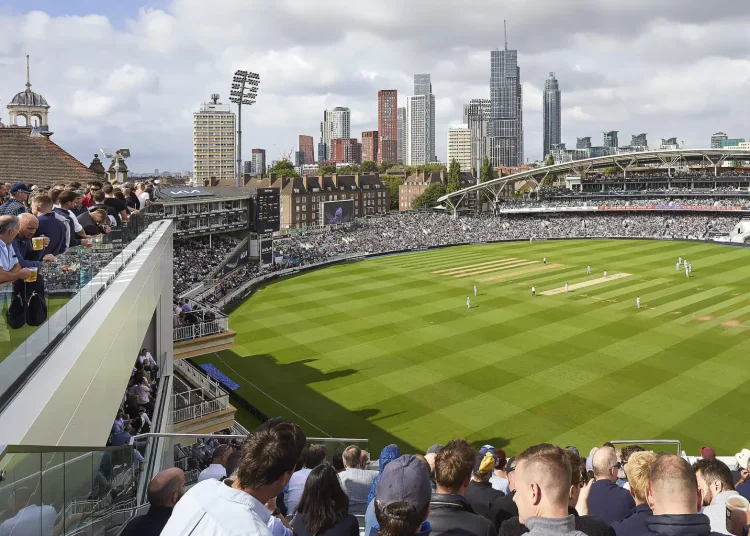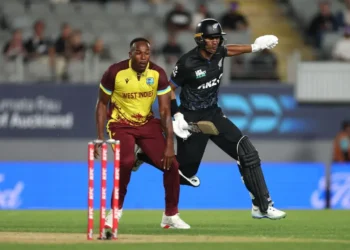The Oval Cricket Ground is a jewel in cricket’s crown. Located in South London, it’s been a stage for epic matches since 1845. From the first Test in England to thrilling Ashes clashes, its legacy is unmatched.
Why is it called The Oval? Is it bigger than Lord’s? Has it hosted World Cup finals? This guide answers these and more. Whether you’re a fan or planning a visit, discover its history, records, and what makes it special. Let’s step into the world of The Oval.
The Oval Cricket Ground is one of cricket’s most iconic venues. Located in South London, it has hosted legendary matches since 1845. From historic Ashes Tests to modern-day thrillers, The Oval holds a special place in cricket history.
Fans often ask: Why is it called The Oval? Or how does it compare to Lord’s? This article answers all such questions, backed by data, records, and real fan experiences.
Whether you’re a tourist, a cricket fan, or just curious, this is your complete guide to The Oval Cricket Ground. Let’s explore its legacy, pitch nature, seating details, and what sets it apart from other venues.
Where is The Oval Cricket Ground Located?
The Oval sits in Kennington, South London, United Kingdom. Officially named the Kia Oval due to sponsorship, it’s a landmark in the city.
Owned by Surrey County Cricket Club (SCCC), it’s near central London attractions. You can reach it easily via Oval Station (Northern Line) or Vauxhall Station (Victoria Line and National Rail).
Why is it Called The Oval in Cricket?
The Oval gets its name from its elliptical shape. Unlike the rectangular fields of the 1800s, its design was unique.
Before cricket, it was a cabbage patch and market garden. In 1845, it was leased for cricket, and the name stuck. This shape offers great viewing angles for fans.
Did You Know? Its design influenced “oval” stadiums worldwide.
How Big is The Oval Compared to Other UK Grounds?
The Oval’s seating capacity is about 27,500. It’s smaller than Lord’s (31,100) but larger than Old Trafford (26,000).
Its field has a straight boundary of 75 meters and a square boundary of 65 meters. This size suits both batsmen and bowlers, ranking it among the UK’s top grounds.
Comparison with Lord’s and Old Trafford
-
The Oval: 27,500 seats, opened 1845, World Cup final host.
-
Lord’s: 31,100 seats, opened 1814, five World Cup finals.
-
Old Trafford: 26,000 seats, opened 1857, semi-final host.
Is The Oval Older Than Lord’s Cricket Ground?
No, The Oval isn’t older than Lord’s. Lord’s opened in 1814, while The Oval began in 1845.
Despite this, The Oval has its own firsts—like hosting England’s debut Test match in 1880. Both grounds are historic, but Lord’s has a 31-year head start.
Fun Fact: The Oval was the first to use artificial lighting for cricket in 1889!
What is the History of The Oval Cricket Ground?
The Oval’s story began in 1845 when it was leased for cricket. It hosted England’s first Test match in 1880 against Australia.
In 1882, it saw the birth of the Ashes after England’s dramatic loss. It also hosted the first FA Cup final in 1872 and early rugby internationals.
Iconic moments include the 2005 Ashes win and India’s 2021 Test triumph. It’s a ground where history is made.
What Makes the Pitch at The Oval Unique?
The Oval is known for its batting-friendly cricket pitch. It’s flat, brown, and carries subtle green shades early in the match. This mix supports attacking stroke play, especially in the first two days.
Consistent Bounce and Flat Surface
The pitch offers true bounce. That helps batsmen play on the front foot confidently. Unlike many English grounds, early swing is moderate here unless there’s heavy morning moisture.
Its flatness makes batting easier early on. Scores over 400 are common in the first innings. It’s a ground where batters trust the bounce and go big.
Changing Behavior Over the Match
Like other English grounds, The Oval changes as the match goes on. Spinners enter the game from Day 3 or 4. The rough patches build up, helping turn and variable bounce late.
It’s often a paradise for batters early and a trap for them late. This natural wear creates results in most Test matches here.
How Weather Affects the Pitch
Cloudy mornings in London help seamers and swing. But as the sun comes out, the surface dries up. That’s when batting becomes smooth. Late afternoons usually bring high scoring unless the ball reverses.
How It Compares to Other Grounds
| Ground | Pitch Type | Unique Feature |
|---|---|---|
| The Oval | Flat, batting-friendly | True bounce, turns late, best for batting early |
| Lord’s | Sloped and grassy | Ball moves sideways due to slope, seamers dominate |
| Old Trafford | Dry and dusty | Best for spin bowling, slow surface |
The Oval rewards both teams if they adapt well. Bat first, bat long — that’s the key to winning here.
Who Owns The Oval Stadium in London?
The Oval is owned by Surrey County Cricket Club (SCCC). Founded in 1845, SCCC has managed the ground ever since.
Today, it’s branded as the Kia Oval due to a sponsorship deal. This partnership keeps it modern while honoring its roots.
Did You Know? The Duchy of Cornwall leases the land to SCCC.
Has The Oval Hosted Any World Cup Finals?
Yes, The Oval hosted the first Cricket World Cup final in 1975. England faced West Indies in a thrilling match, with West Indies winning.
It’s also hosted other ICC events, like the 2019 World Cup matches. While Lord’s has more finals, The Oval’s 1975 moment is legendary.
Fun Fact: The 1975 final drew 26,000 fans!
Why is The Oval Considered a Batting-Friendly Pitch?
The Oval’s pitch is a batsman’s dream early on. It’s flat and true for the first three days, with fast outfields and good bounce.
By Day 4, it helps spinners and reverse swing, balancing the game. This mix makes it exciting and high-scoring.
Expert Insight: Recent Tests show big first-innings totals and tight finishes, like South Africa against New Zealand.
Why The Oval Is Called the Birthplace of The Ashes?
The Ashes rivalry began at The Oval in 1882. Australia beat England on English soil for the first time. This loss stunned the British public and press.
The Match That Changed History
England lost to Australia on August 29, 1882. After the match, The Sporting Times printed a mock obituary for English cricket. It said the “body will be cremated and the ashes taken to Australia.”
This satire became legendary. England’s next captain, Ivo Bligh, vowed to reclaim the Ashes on their tour to Australia.
A Small Urn, A Big Rivalry
During that return tour, Bligh was given a small urn by some Australian women. That urn became the symbol of the Ashes series — one of cricket’s fiercest rivalries.
The original urn is now kept at Lord’s, but the symbolic importance lives on. Every England–Australia Test is a battle for those mythical Ashes.
The Oval’s Role in Cricket Legacy
The Oval is remembered for this historic moment. It’s more than just a venue — it’s where cricket’s biggest story began. From satire to legend, the Ashes live on because of what happened at The Oval.
Which Famous Records Were Made at The Oval?
The Oval boasts incredible records:
-
Highest Test Total: 903/7 by England vs. Australia (1938).
-
Most Test Wickets: James Anderson with 30 wickets.
-
Fastest ODI Fifty: AB de Villiers in 16 balls (2015).
Memorable centuries include Len Hutton’s 364 (1938) and Rohit Sharma’s 127 (2021). It’s a ground for legends.
How Do I Reach The Oval Cricket Stadium in London?
Getting to The Oval is simple:
-
Tube: Oval Station (2 mins walk), Vauxhall Station (10 mins).
-
Bus: Routes 3, 59, 159, 185 stop nearby.
-
Train: Vauxhall from Waterloo or Clapham.
-
Car: Limited parking—book ahead or use nearby lots.
It’s perfect for locals and tourists alike.
Pro Tip: Public transport beats parking hassles, like sri lanka pitches.
What Makes The Oval Different From Other Cricket Venues?
The Oval’s elliptical shape sets it apart. It offers unique sightlines and a cozy feel despite its size. Its urban setting—with gasholders as a backdrop—adds character. The pitch’s evolution and rich history make it stand out too.
Did You Know? It’s nicknamed “The Cabbage Patch” from its past!
What Facilities Are Available at The Oval Ground?
The Oval has four main stands: Pavilion End, Peter May, Bedser, and Galadari. It offers:
-
Luxury boxes and family zones.
-
Disabled-friendly seating.
-
Restaurants and The Oval Store.
Surrey Members enjoy exclusive perks. It’s built for comfort and enjoyment.
Which Teams Use The Oval as Their Home Ground?
Surrey County Cricket Club is the primary team. Also, the Oval hosts England Men’s and Women’s internationals. It’s a hub for Ashes Tests, World Cups, and county finals. Stars like James Anderson and Rohit Sharma shine here.
The Oval Cricket Ground is more than a venue—it’s a cricket icon. Its history, records, and atmosphere draw fans worldwide.
From its batting-friendly pitch to its unique shape, it’s unforgettable. Whether you’re visiting or watching from afar, The Oval’s magic endures. Plan a trip, explore its legacy, and see why it’s loved by millions.
















